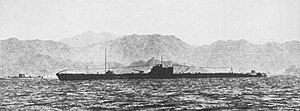Japanese submarine I-175
 Japanese submarine I-175 in 1941
| |
| History | |
|---|---|
| Name | I-75 |
| Ordered | 1934 |
| Builder | Mitsubishi Heavy Industries, Kobe |
| Laid down | 1 November 1934 |
| Launched | 16 September 1937 |
| Commissioned | 8 December 1938 |
| Renamed | I-175, 1942 |
| Stricken | 10 July 1944 |
| Fate | Sunk by destroyers, 4 February 1944 |
| General characteristics | |
| Class and type | Kaidai type (KD6B Type) |
| Displacement |
|
| Length | 105 m (344 ft 6 in) |
| Beam | 8.2 m (26 ft 11 in) |
| Draft | 4.57 m (15 ft 0 in) |
| Installed power |
|
| Propulsion | |
| Speed |
|
| Range |
|
| Test depth | 75 m (246 ft) |
| Complement | 70 |
| Armament |
|
The Japanese submarine I-175 (I-75, until 20 May 1942) was a Kaidai type of cruiser submarine of the KD6B sub-class, built for the Imperial Japanese Navy (IJN) during the mid-1930s.
Design and description
The submarines of the KD6B sub-class were essentially repeats of the preceding KD6A sub-class. They displaced 1,814 tonnes (1,785 long tons) surfaced and 2,605 tonnes (2,564 long tons) submerged. The submarines were 105 meters (344 ft 6 in) long, had a beam of 8.2 meters (26 ft 11 in) and a draft of 4.57 meters (15 ft 0 in). The boats had a diving depth of 75 m (246 ft)[1]
For surface running, the boats were powered by two 4,500-brake-horsepower (3,356 kW) diesel engines, each driving one propeller shaft. When submerged each propeller was driven by a 900-horsepower (671 kW) electric motor. They could reach 23 knots (43 km/h; 26 mph) on the surface and 8 knots (15 km/h; 9.2 mph) underwater.[2] On the surface, the KD3Bs had a range of 10,000 nautical miles (19,000 km; 12,000 mi) at 16 knots (30 km/h; 18 mph); submerged, they had a range of 65 nmi (120 km; 75 mi) at 3 knots (5.6 km/h; 3.5 mph).[3]
The boats were armed with six internal 53.3 cm (21.0 in) torpedo tubes, four in the bow and two in the stern. They carried a total of 14 torpedoes. They were also armed with one 120 mm (4.7 in) deck gun for combat on the surface and two 13.2 mm (0.52 in) anti-aircraft machineguns.[3]
Career
I-175 participated in the Attack on Pearl Harbor and sank 3,252-ton American merchant Manini on 17 December 1941, 180 miles south of Hawaii. In July 1942 she operated off the eastern coast of Australia and sank the French merchant vessel Cagou, the Australian trawler Dureenbee and damaged the Australian merchant vessels Allara and Murada. I-175 was depth charged by HMAS Cairns on 26 July 1942 and evaded destruction.
On 12 August, the submarine was damaged by aircraft from USS Enterprise and needed repairs at Rabaul. I-175 was damaged in a collision with the oiler Nisshin Maru on 20 November 1942 at Truk and run aground to prevent from sinking. The submarine required repairs at Yokosuka.
I-175 is best known for sinking Escort carrier USS Liscome Bay on 24 November 1943, killing 54 officers and 648 enlisted men.
I-175 was herself sunk 2 months later on 4 February 1944, during the Battle of Kwajalein, when she was attacked by destroyers USS Charrette and Fair. The Fair fired several grenades from its Hedgehog anti-submarine mortar at the Japanese submarine and sank her with the entire crew at position (6°48′N 168°8′E / 6.800°N 168.133°E).
Notes
References
- Bagnasco, Erminio (1977). Submarines of World War Two. Annapolis, Maryland: Naval Institute Press. ISBN 0-87021-962-6.
- Carpenter, Dorr B.; Polmar, Norman (1986). Submarines of the Imperial Japanese Navy 1904–1945. London: Conway Maritime Press. ISBN 0-85177-396-6.
{{cite book}}: Unknown parameter|lastauthoramp=ignored (|name-list-style=suggested) (help) - Chesneau, Roger, ed. (1980). Conway's All the World's Fighting Ships 1922–1946. Greenwich, UK: Conway Maritime Press. ISBN 0-85177-146-7.
- Hackett, Bob; Kingsepp, Sander (2001). "IJN Submarine I-175: Tabular Record of Movement". Combinedfleet.com.
{{cite web}}: Unknown parameter|lastauthoramp=ignored (|name-list-style=suggested) (help)
